Choosing the Ideal Bird Cage for Lovebirds
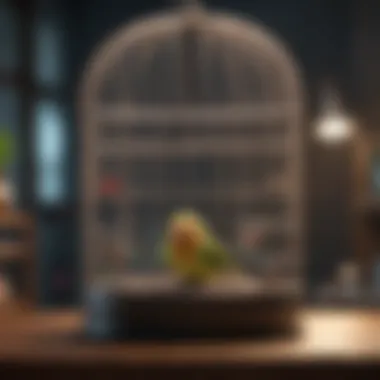
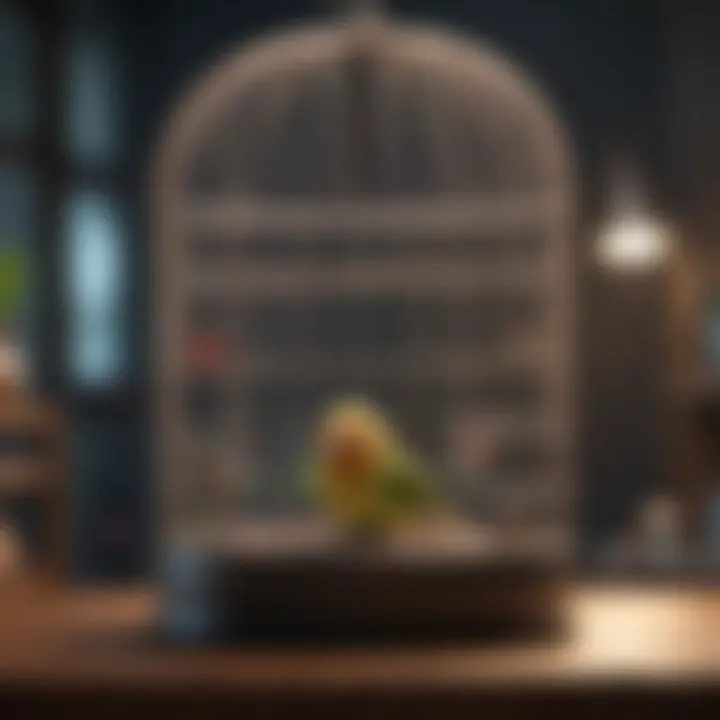
Intro
Selecting the right cage for your lovebirds is a task that goes beyond mere aesthetics. It involves understanding their unique needs as social creatures that thrive on interaction and stimulation. A well-designed cage can promote both physical health and emotional well-being. This guide will detail important factors to consider when choosing an ideal bird cage, addressing sizing, materials, designs, and necessary accessories.
A good cage mimics a lovebird's natural habitat, allowing it to feel safe and comfortable. Owners should prioritize not only the dimensions and construction of the cage but also the internal environment that includes enrichment opportunities.
By giving careful thought to these elements, you can ensure your companions lead vibrant, healthy lives. Let's explore the various aspects of cage selection that can contribute to the happiness of your lovebirds.
Prolusion to Lovebirds
Lovebirds are charming and vibrant companions for many pet owners. They are known for their affectionate behavior towards each other and their playful nature. Understanding lovebirds is pivotal because their unique characteristics influence not only their care but also their living environment. This article showcases how to choose the right bird cage for lovebirds, focusing on their specific needs.
Understanding Lovebird Behavior
Lovebirds are inherently social animals. They form strong bonds with their partners, and this affection extends to their human caretakers. They thrive on interaction and play, often displaying behaviors that exhibit their intelligence and curiosity. Recognizing these traits is essential when selecting their cage. A proper cage can provide not only a home but also a stimulating environment that aligns with their behaviors. Having multiple levels, perches, and toys can enrich their lives and keep them physically active.
A well-designed cage allows for adequate space to flutter and engage in their natural behaviors. Lovebirds require physical activity to remain healthy. If they are confined to too small a space, they may become bored, leading to stress or harmful behaviors. Therefore, a thorough understanding of lovebird behavior guides the selection process, ensuring that the cage supports their instincts and well-being.
Social Needs of Lovebirds
Socialization is a core element in the life of a lovebird. Keeping lovebirds in pairs or groups is often recommended because it aligns with their natural tendencies. They are very vocal and communicate with each other through sounds and body language. A cage that accommodates companionship will result in happier, healthier birds.
Cages should provide enough room for lovebirds to interact without overcrowding. This means not only an adequate width and height but also sufficient depth to allow movement around each other. Avoiding solitary confinement is vital. Associating cages with isolation can lead to emotional distress. In summary, understanding the social needs of lovebirds is critical to foster a harmonious environment.
"Lovebirds thrive in companionship; their emotional health hinges on socialization."
Providing a suitable cage that matches their social nature ensures they can engage in their essential interactions, promoting overall well-being and longevity. As we move through this article, we will explore other significant aspects that contribute to making an ideal home for these delightful birds.
Importance of Proper Housing
The housing of lovebirds is crucial for maintaining their overall well-being. Proper housing contributes significantly to their physical, mental, and emotional health. If the cage environment is not optimal, it can lead to various behavioral issues and health problems for lovebirds.
Creating a suitable habitat allows lovebirds to express their natural behaviors. Lovebirds are social creatures, and their housing must accommodate their need for movement and interaction. Proper housing promotes a safe space where they can fly, perch, and explore, thus reducing stress and anxiety. Stress in lovebirds can result in feather plucking, aggressive behavior, or depression.
Choosing the right cage ensures that lovebirds can live vibrant lives filled with activity. The size, layout, and overall design of the cage affect their physical health and daily life. A well-designed cage mimics aspects of their natural environment, facilitating behaviors such as climbing and playing.
Furthermore, the right environment provides mental stimulation. Lovebirds thrive when they can interact with toys and organic materials that challenge their minds. A lack of appropriate activities and space can lead to boredom. Consequently, ensuring proper housing is not just about physical space, but also about providing an enriching experience for your birds.
"Comfortable housing is key to a lovebird's happiness and longevity."
Physical and Mental Well-being
Physical and mental well-being are intertwined aspects of a lovebird’s health. A spacious cage allows for physical exercise, which is vital. Lovebirds need room to fly short distances and engage in climbing. Even short bouts of flight can contribute to muscle development and overall fitness. A cramped cage only leads to a sedentary lifestyle, putting them at risk for obesity and heart diseases.
Mental well-being is equally important. Lovebirds can become bored without sufficient stimulation, leading to destructive behaviors. A thoughtfully designed cage incorporates several elements:
- Perches at different heights: This allows lovebirds to exercise and explore vertically.
- Toys that promote engagement: These can include swings, mirrors, and foraging toys that stimulate their minds.
- Natural materials: Offering materials like branches from safe trees can satisfy their instinct to chew and explore.
These features contribute significantly to their physical health and mental engagement, creating a happy and healthy environment.
Impact on Lifespan
The condition of a lovebird’s cage impacts its lifespan directly. Proper housing can extend a lovebird's life by fostering health and reducing stress. A stressed bird may develop health problems that can shorten its life span. For example, a lack of space can hinder movement, leading to obesity and associated health issues.
Moreover, a clean and well-maintained cage minimizes the risk of disease. Regular cleaning and an appropriate setup eliminate bacteria and fecal matter that can cause respiratory issues and infections.
In summary, investing time and resources into the right housing will pay dividends in your lovebird’s longevity. By focusing on both physical space and mental engagement, owners can create an environment conducive to health, happiness, and extended life.
Key Factors in Selecting a Cage
When it comes to providing a suitable environment for lovebirds, selecting the right cage is paramount. This decision greatly impacts their physical comfort and emotional health. Certain elements of the cage should be carefully considered to ensure the well-being of these social creatures. These considerations include dimensions, shape, and bar spacing. Each aspect not only plays a role in comfort but also in facilitating their natural behaviors.
Cage Dimensions
Dimensions of a cage are among the first thoughts to consider. Lovebirds need ample space to move and interact. An adequately sized cage allows them to fly, exercise, and engage in social behaviors vital for their health.
Width and Height Requirements
The width and height of a cage are essential for several reasons. Lovebirds are active and enjoy flying short distances. A cage that is wider offers them the opportunity to make these flights comfortably. Height is also significant; different levels allow lovebirds to feel secure, as they would in their natural settings. Most experts recommend a minimum dimension of 30 inches in width and a height of at least 36 inches.
Key Characteristics: This type of setup benefits lovebirds by preventing feelings of confinement and promoting exercise. The broader space reduces stress, fosters better mood, and encourages normal behaviors.
Advantages: Wider cages help prevent aggression among paired birds and provide room for play with toys.
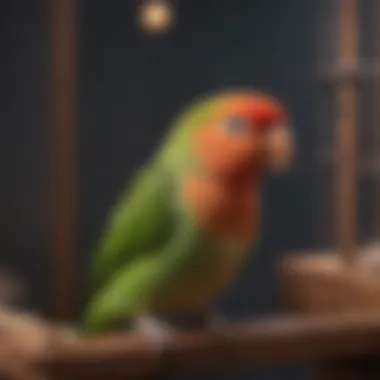
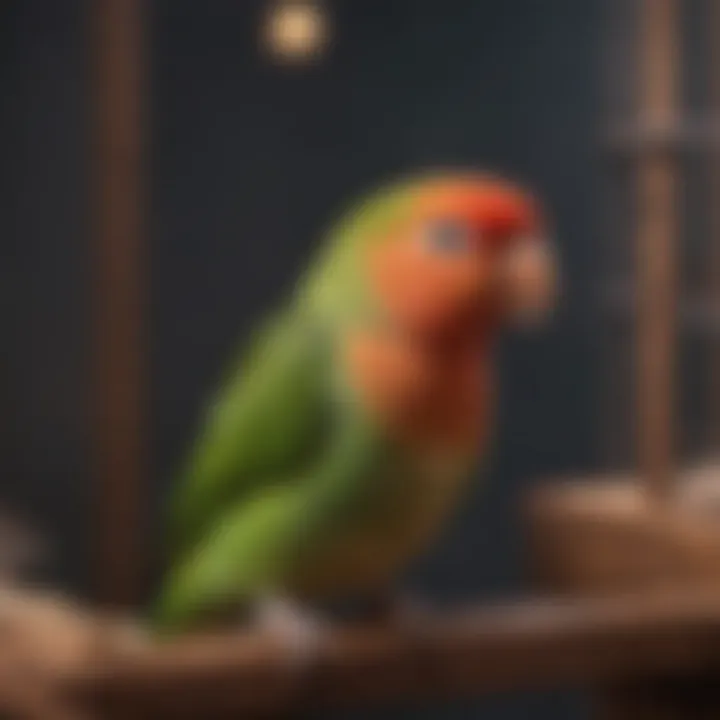
Depth Considerations
Depth is another integral dimension. A deep cage can offer more space where toys, perches, and food can be arranged. This layout mimics their natural environment, which gives mental stimulation.
Key Characteristics: A depth of at least 18 inches is often recommended. This allows for comfortable placement of various elements inside the cage.
Advantages: Depth supports a more enriching setting, enabling the birds to explore and engage more thoroughly with their space. It also lessens the chance of them getting stuck during their activities.
Cage Shape
The shape of the cage can also influence how lovebirds interact and behave within it. Various configurations can cater to specific needs.
Rectangular vs. Round Cages
The choice between rectangular and round cages is significant. Rectangular cages tend to be the preferred style due to their spacious layout. They provide room for multiple perches and toys, which creates diverse activity zones. This shape allows for easy access to all parts of the cage, essential for maintaining hygiene and aiding interaction between birds.
Key Characteristics: Rectangular options can efficiently stabilize space for multiple lovebirds.
Advantages: Because of their shape, rectengular cages promote better aeration and circulation than round cages. Birds can utilize the space more freely, which is critical for their mental stimulation.
Multi-Level Options
Multi-level cages add another dimension to the environment of your lovebirds. They allow for vertical space use, integrating shelves and ladders.
Key Characteristics: These cages cater to the natural climbing habits of lovebirds. When a cage has levels, it can host more play areas, stimulating exploration and activity.
Advantages: Multi-level options enable owners to create a rich ecosystem, promoting interaction and reducing boredom. Lovebirds can choose their preferred level, providing a sense of security.
Bar Spacing
Bar spacing is crucial in ensuring that lovebirds cannot escape or get stuck. Choosing the right spacing can mean the difference between safety and potential danger.
Recommended Bar Spacing
The recommended spacing typically ranges from 1/2 to 3/4 inches. This measurement ensures that even the smallest lovebirds cannot slip through the bars.
Key Characteristics: Proper spacing provides birds the freedom to climb, escape tight spots, and remain secure.
Advantages: Correct bar spacing creates a safe environment for your lovebirds. It ensures they cannot accidentally injure themselves or escape, maintaining peace of mind for the owner.
Risks of Incorrect Spacing
Not adhering to the recommended bar spacing can present significant risks. If the bars are too far apart, your lovebirds may squeeze out. Also, bar spacing that is too close can lead to injuries as they attempt to maneuver.
Key Characteristics: Birds can experience stress and anxiety if they feel trapped or if escape seems impossible.
Advantages: By being aware of spacing, you can avoid injuries and a possible escape, thus ensuring the safety and comfort of your lovebirds.
Material Considerations
The choice of materials for a lovebird cage plays a crucial role in creating a safe, comfortable environment. Understanding the differences in cage materials is vital for anyone looking to provide the best habitat for their lovebirds. Each material has its own set of characteristics that can impact the birds’ physical health and emotional well-being. Choosing suitable materials not only influences durability and maintenance but also affects the overall atmosphere within the cage.
Metal vs. Plastic Cages
When comparing metal and plastic cages, it’s essential to recognize their distinct advantages and disadvantages. Metal cages, such as those made from stainless steel or powder-coated materials, are often preferred due to their durability. They resist chewing and scratching by the birds. Thus, these cages generally have a longer lifespan compared to plastic alternatives. On the other hand, plastic cages can be lighter and easier to move, making them appealing for some owners. However, they are more susceptible to damage and may not hold up against lovebirds that like to chew.
In terms of hygiene, metal cages are easier to clean and maintain, thus preventing the buildup of waste and bacteria. Plastic cages may require more attention to ensure cleanliness, as certain materials can harbor germs over time.
Non-Toxic Coatings
Identifying Safe Materials
Identifying safe materials is paramount when selecting a cage for lovebirds. Non-toxic coatings ensure that whatever surface the birds interact with will not pose health risks. Look for metal cages with powder-coated finishes. This type of coating is both durable and safe. Good quality paint will not flake off over time, reducing the risk of ingestion.
Another key characteristic to consider is whether the materials are free from heavy metals and harmful chemicals. This is beneficial for lovebirds, as their health is sensitive to toxins. Safe materials will help maintain their overall well-being and prevent potential health issues.
Potential Hazards in Coatings
While selecting cages, understanding potential hazards in coatings is equally important. Even non-toxic coatings can become problematic if they are poorly applied or deteriorate over time. For instance, if a coating begins to chip, it can expose the metal underneath, which may not be safe for ingestion.
Thus, it is essential to regularly check the cage for any signs of wear or damage. Choose coatings from reputable brands known for quality assurance. Avoid cages with coatings that don’t provide clear safety information. This will help ensure the long-term safety of the birds in their habitat.
Experts recommend checking labels and product descriptions carefully to confirm that materials are non-toxic and safe for birds.
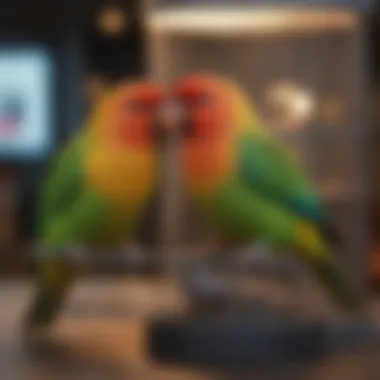
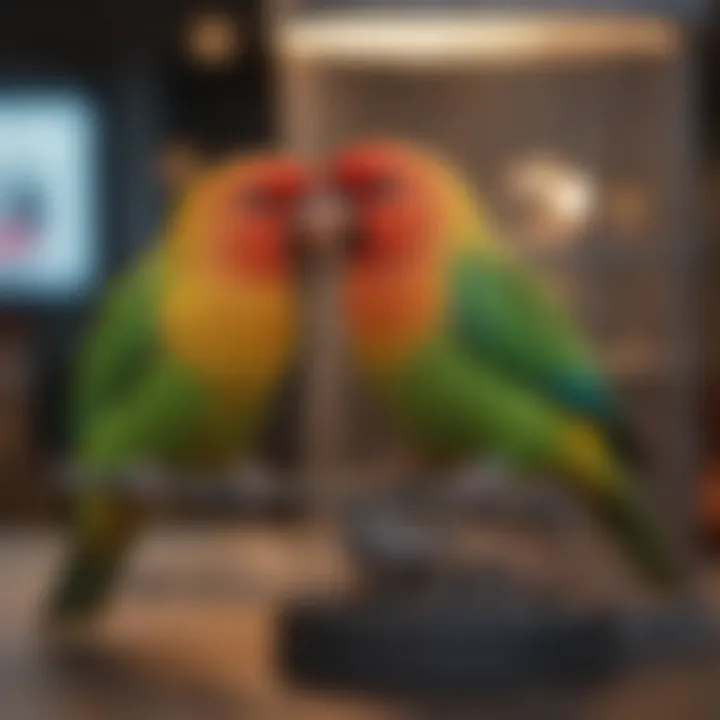
Ultimately, material considerations play an essential role in bird cage selection. Prioritizing safe, durable materials will contribute to a healthier and more secure environment for lovebirds.
Essential Cage Accessories
Understanding the essential accessories for a lovebird cage is crucial for creating an ideal living space for these social creatures. Proper accessories significantly contribute to their overall well-being. This section outlines the key elements required for a comprehensive cage environment and discusses their importance in promoting both comfort and stimulation for lovebirds.
Perches and Their Placement
Natural Wood Perches
Natural wood perches are a prominent choice for lovebird cages. Made from untreated wood, they provide a natural surface that mimics the branches in their native habitat. One primary advantage of natural wood perches is that they help exercise the bird's feet. The texture allows lovebirds to grip more naturally, reducing the risk of foot problems. Additionally, wood is a more pleasant material for the birds compared to plastic or metal alternatives.
However, it is essential to select wood that is safe for birds. Avoid any treated woods, as the chemicals can be harmful. Ensure the perches are of various diameters to promote foot health.
Sandy Perches for Claw Care
Sandy perches provide a practical solution for claw maintenance. These perches are coated with abrasive materials that help to naturally wear down a lovebird's claws, preventing overgrowth. This regular wear is important for the physical health of the birds. A well-maintained claw length is essential for their movement and overall comfort.
One downside to sandy perches is that they can be rough on a bird's feet if they are not placed correctly or if the lovebird spends too much time on them. Rotate the perches in the cage to ensure that lovebirds have a variety of surfaces to choose from, promoting healthy foot conditions.
Food and Water Containers
Types of Feeders
Feeders come in various styles and sizes to accommodate the feeding habits of lovebirds. It's important to select feeders that minimize mess while allowing easy access to food. A good choice is the gravity style or trough feeders, as they ensure that food is always available to the birds. These styles allow lovebirds to eat comfortably without much spill-over.
Some feeders also feature special designs that prevent birds from spilling their food quickly. This ensures that the area stays cleaner, reducing the need for daily clean-up tasks. However, be cautious of feeders that may hold too much food, as it could spoil if not consumed in time.
Water Bottles vs. Bowls
When considering water containers, there are primarily two options: bottles and bowls. Water bottles are advantageous as they keep the water clean for a longer period. They reduce the chances of contamination from spilled food and droppings. Many bird owners find bottles less messy and easier to manage. The downside is that birds can sometimes have trouble learning to use them.
On the other hand, bowls offer easy access for drinking, and it is natural for lovebirds to drink from them. However, bowls may need frequent replacement, as they can collect debris and may become dirty quickly. Ultimately, the choice between water bottles and bowls depends on the owner's preference and the habits of the lovebirds.
Toys for Mental Stimulation
Types of Toys
Variety in toys is vital for keeping lovebirds mentally engaged. There are many types of toys such as chew toys, bells, and foraging toys designed specifically for small birds. Toys made from safe materials, like untreated wood and natural fibers, encourage play and exploration.
Adding toys helps fulfill their natural instincts to chew and forage. Chewing helps keep their beaks healthy, while foraging toys stimulate natural hunting behaviors, preventing boredom. An important consideration is to ensure that toys are free from harmful chemicals and small parts that could pose choking hazards.
Rotation and Enrichment Strategies
To maintain interest in their environment, rotation of toys is highly recommended. By changing the toys every few weeks, lovebirds are given fresh stimuli, keeping their environment dynamic. Enrichment strategies such as hidden treats in toys can also boost their mental engagement. These practices support cognitive health and enhance the overall well-being of lovebirds.
By observing which toys are most engaging for your lovebirds, one can tailor the selection over time, ensuring they remain entertained without overstimulation.
"Providing the right accessories is as important as the cage itself in ensuring lovebirds thrive in their environment."
Cage Location and Environment
The placement and surroundings of a lovebird’s cage are crucial for its overall health and happiness. A well-chosen location can help to create a comfortable atmosphere that mimics the bird's natural habitat. This section discusses optimizing cage location and environment to enhance lovebirds’ well-being.
Optimizing Cage Location
Light and Temperature Considerations
Light plays a significant role in lovebird behavior and health. Natural sunlight can provide essential vitamins and support their circadian rhythms. Therefore, placing the cage in a spot that gets natural light is beneficial. However, care must be taken not to expose lovebirds to direct sunlight for extended periods, as this can lead to overheating.
- Key Characteristic: Natural light contributes to vital vitamin D production.
- Why it’s Popular: Many bird owners prefer sunny areas for their natural benefits.
- Unique Feature: The warmth from indirect sunlight can be soothing for lovebirds, promoting a sense of security and comfort.
However, lmit it to a few hours during cooler seasons to avoid abrupt temperature changes.
Avoiding Direct Sunlight
Direct sunlight can be harmful for lovebirds. Excessive exposure can raise the cage's interior temperature dramatically and may cause heat stress or overheating, especially during hot summer months.
- Key Characteristic: Avoiding direct sunlight is crucial for preventing health issues.
- Why it’s Beneficial: This approach ensures a stable, comfortable environment throughout the day.
- Unique Feature: Lovebirds can get stress from the light’s intensity, which can lead to health problems.
Ensure the bird cage is near a window but with some cover, such as trees or curtains, to filter harsh rays. This balance provides light without overheating.
Creating a Calm Environment

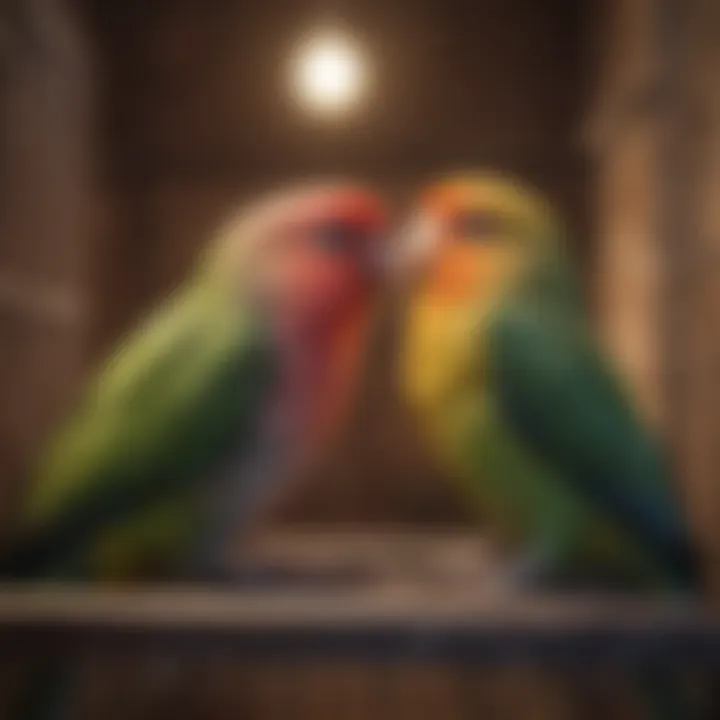
Creating a peaceful environment around the cage can greatly influence a lovebird's behavior and health. Minimizing stressors is key to ensuring that lovebirds feel secure.
Noise Reduction Tips
Excessive noise can distress lovebirds, leading to anxiety and health issues. Strategies to minimize noise include placing the cage away from loud appliances, heavy foot traffic areas, or other pets.
- Key Characteristic: A quiet environment aids in lowering stress levels.
- Why it’s Popular: Owners notice improved behaviors when birds are in a serene space.
- Unique Feature: Sounds from television or loud conversations can startle lovebirds, affecting their comfort.
Consider using soft fabrics to cushion sounds or placing the cage in a quieter room while interacting with them regularly to maintain social connections.
Interacting with Lovebirds
Interaction plays a vital role in a lovebird’s daily life. Regularly spending time near the cage can help the bird adjust to your presence, thereby fostering a sense of security.
- Key Characteristic: Interaction encourages sociability and reduces fear of humans.
- Why it’s Beneficial: Lovebirds are highly social and thrive with companionship.
- Unique Feature: Engaging with them can improve their overall mood and behavior.
Spend time talking or sitting near the cage to build trust. Avoid sudden movements that may frighten them. Understanding how to create a calming, interactive environment is essential for lovebird care.
Maintenance and Cleaning
Proper maintenance and cleaning of a lovebird cage is paramount for the health and happiness of these creatures. A clean environment reduces the risk of illness and promotes a sense of well-being. Neglect can lead to a buildup of waste and bacteria, which poses significant health risks. Keeping a consistent cleaning routine can help maintain a healthy habitat and ensure that lovebirds lead a comfortable life.
Food debris and droppings are a part of having birds. Without regular cleaning, cages can become unsightly and unhygienic. Cleaning helps to control odors and provides a visually appealing environment. Moreover, lovebirds are curious creatures. They often explore their surroundings. A dirty cage can deter them from interacting with their environment, which can decrease their physical activity and mental stimulation.
Regular Cleaning Routines
Daily vs. Weekly Tasks
Daily cleaning tasks typically include removing any leftover food and droppings from the cage floor and changing the water. This routine keeps the immediate environment clean and encourages the birds to eat and drink confidently. The key characteristic is that daily tasks are manageable and can be done quickly, preventing a larger buildup of waste over time.
On the other hand, weekly tasks may involve more thorough cleaning, like washing all perches, toys, and the cage itself. This more extensive cleaning addresses hidden areas where waste may accumulate. This is beneficial, as it allows for a comprehensive inspection of the cage and its accessories. The unique feature of weekly tasks is the opportunity for deeper hygiene checks, but they require more time and effort to ensure everything is clean.
Tools and Solutions
Having the correct tools and solutions is essential for effective cleaning. Many bird owners find that using a mixture of water and white vinegar is an effective and safe cleaning solution. The key characteristic of these tools is their accessibility; most pet owners have them readily available.
Another important aspect is having specific cleaning brushes designed for bird cages. These can reach into small, difficult areas that standard brushes cannot. However, there may be some disadvantages in that these cleaning supplies take time to use and need frequent replacement. Investing in suitable tools is crucial for maintaining a clean and safe habitat for lovebirds.
Preventing Bacterial Build-Up
Preventing bacterial build-up in a lovebird cage requires consistent and thorough cleaning practices. When a cage is not adequately cleaned, dangerous bacteria can proliferate, leading to health issues in lovebirds. Symptoms can manifest as respiratory problems, diarrhea, or skin infections. To mitigate these risks, it is essential to regularly check for any signs of mold or mildew, especially in damp areas.
Utilizing cage liners can help control waste and provide a barrier against bacteria. Additionally, consider every piece of equipment in the cage; perches, toys, and food containers should all be washable and treated as potential sources of contamination.
Regular maintenance and thorough cleaning can help prevent health risks associated with bacteria, ensuring that lovebirds thrive in their environment.
Common Mistakes in Cage Selection
Selecting the right cage is fundamental for the health and happiness of lovebirds. However, many owners commit errors that can have lasting effects on these delicate pets. Understanding these common mistakes is essential. Avoiding these pitfalls creates a safe and stimulating environment for your lovebirds.
Choosing Too Small a Cage
One of the most prevalent mistakes is opting for a cage that is too small. Lovebirds are active and social creatures. They need ample space to move, fly, and explore. A cramped environment not only limits their physical activity but can also lead to behavioral issues.
Small cages can restrict natural movement, potentially causing frustration and stress in lovebirds. This could manifest in destructive behavior or excessive vocalization. For their wellbeing, consider a cage that provides sufficient height and width, allowing your lovebirds to stretch their wings.
To evaluate if a cage is adequate, observe your bird's behavior. If they seem agitated or cooped up, it may be time to upgrade. The ideal cage should have dimensions that align with their need for space. This can encourage play and interaction with their environment, enhancing their overall health.
Ignoring Lovebird Socialization Needs
Lovebirds are inherently social animals; they thrive on interaction. Another common mistake is neglecting their socialization requirements. A cage alone cannot fulfill their need for companionship. Lovebirds often do better in pairs. This not only meets their social needs but can also prevent loneliness, which may lead to stress and depression.
When selecting a cage, think about how it allows for interaction. Placing multiple perches and toys throughout the cage can facilitate play and social bonding. If your lovebird is alone, spending quality time outside the cage daily is crucial. This way, you can provide the stimulation they need.
"Socialization is critical for lovebirds. Engaging them enriches their lives and fosters emotional stability."
Culmination
Selecting the right cage for your lovebirds is paramount for their overall well-being. A well-chosen cage factors in aspects such as size, shape, and material as pivotal components that shape the living conditions of these social creatures.
Summary of Key Points
- Cage Size: Ensure the cage is sufficiently spacious for two or more lovebirds. It promotes their physical activity and reduces stress.
- Cage Shape: Rectangular cages typically provide more flight space than round ones. Multi-level cages can enhance enrichment opportunities.
- Bar Spacing: Proper spacing prevents accidental escapes and injuries. It is crucial to adhere to the recommended spacing for lovebirds.
- Materials: Opt for cages constructed of non-toxic, durable materials. Avoid cages coated with harmful chemicals.
- Accessories: Provide a variety of perches, toys, and containers to stimulate mental and physical engagement.
- Maintenance: Regular cleaning routines will help maintain a healthy environment, preventing bacterial growth that could harm your birds.
Final Thoughts on Lovebird Care
Remember, a safe and enriching environment aids not only in their longevity but also in their happiness. These colorful companions thrive when they feel secure and stimulated within their habitat.
By prioritizing their needs through proper cage selection, you ensure that your lovebirds lead fulfilling lives.















